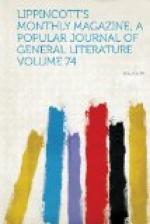The next morning the two called again, when the gentleman made an examination of the room selected the day before, having met Mr. Brown in the hall-way and invited him in. On entering, the new occupant took from his pocket a piece of chalk and a compass and made a number of circles and figures on the floor to determine when the sun would shine in the room. Brown watched him with a certain degree of curiosity and amusement, and finally, concluding he was half crazy, returned to his own studio.
The next day the cicerone called alone to see about some repairs, when Brown hailed him: “Buono giorno. Che e questo?” ("Good-day. Who is that?”)
“Non sapete?” ("Don’t you know?"), was the Italian’s response. “Why, that is the celebrated Brullof.”
Brown started as though shot. First there flashed through his brain the remembrance of how cavalierly he had treated the distinguished artist, and then a quick panorama of his recent history, which had been the gossip of studios and art-circles for some time back. “I must go to him,” he said, “and apologize for not treating him with more deference.”
“Non, signore,” was the cicerone’s response. “Never mind: let it rest. He is a man of the world, and pays little heed to such things. Besides, he is so overwhelmed with his private griefs that he has probably noticed no slight.”
However, when the great Russian artist took possession of his studio his American brother of the pencil made his apology, and received this response; “Don’t waste words on so trivial a matter. Do I not court the contempt of a world that I despise to my heart’s core? Say no more about it. Run in and see me when agreeable; and if you have no better callers than such a plaything of fate as I, maybe you will not refuse me occasional admittance.”
The Russian artist now shunned notoriety as he had formerly courted it. Little is known of his history beyond mere rumor, and that only in artistic circles. He was born at St. Petersburg in 1799 or 1800, and gave himself to the study of art at an early age, becoming an especial proficient in color and composition. One of his most widely-known works is “The Last Days of Pompeii,” which created great enthusiasm a quarter of a century ago. This, however, was painted during his career of dissipation, and its vivid coloring seemed to have been drawn from a soul morbid with secret woes and craving a nepenthe which never came.
The young artist was petted and idolized by the wealth and nobility of St. Petersburg, where he married a beautiful woman, and became court-painter to the czar Nicholas about the year 1830. For some years no couple lived more happily, and no artist swayed a greater multitude of fashion and wealth than he; but scandal began to whisper that the czar was as fond of the handsome, brilliant wife of the young court-painter as the cultivated people of St. Petersburg were of the husband’s marvelously colored works; and when at last the fact became known to Brullof that the monarch who had honored him through an intelligent appreciation of art had dishonored him through a guilty passion for his wife, he left St. Petersburg, swore never again to set foot on Russian soil or be recognized as a Russian subject, and, plunging headlong into a wild career of dissipation, was thenceforth a wanderer up and down the continent of Europe.




